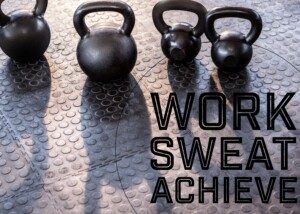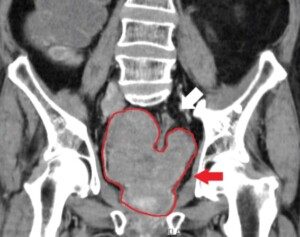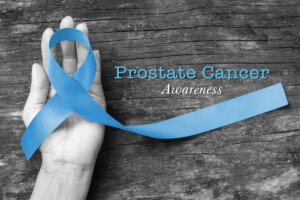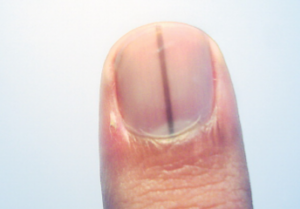Can we end this madness already – that your body will “bulk up” if you just look at weights?
Strength training is incredibly important for women’s bodies, especially after menopause.
It’s unreal the number of women I’ve encountered throughout my life who’ve literally told me, “If I even look at a weight I’ll bulk up.”
This statement, or something similar, has come from women of varying body weights – from slender to medium to a little heavy to obese to morbidly obese.
What makes this phenomenon even more striking is that sometimes it comes from middle age women.
By the time a woman — who’s never strength trained nor has regularly engaged in resistance-based activities such as wall climbing, reaches 50 — she will have lost up to 10 pounds of muscle.
The loss of calorie-burning muscle is due to a slowing down of resting metabolism that begins at around 30, and this slow-down is due to gradual loss of muscle mass — which actually can be very well-preserved with strength training.
The latest woman to inform me that if she just looks at a barbell she’ll pack on muscle is in her 50s.
Let’s call her Jane. She’s obese but has lost 80 pounds through diet and non-resistance exercise.
Jane’s 25-year-old daughter Jordynn is maybe 15 pounds overweight – and that’s not a big issue at all.
The bigger issue is that Jordynn told me the same doggone thing: “I’ll bulk up if I lift weights.”
Neither of these women look naturally muscular or even athletic, for that matter.
Jordynn looks very average and isn’t into any sports. In fact, she looks like she doesn’t exercise beyond maybe some light aerobics.
Jane exercises, as mentioned, and looks like the average 50ish woman with some weight to lose.
So where this mother and daughter have come up with the fallacy that they’ll pack on muscle if they take up strength training is beyond me.
They remind me of a former neighbor who told me she avoids strength training because it would “make me bulk up.”
She showed me a picture of herself during her strength training days of the past, during which she believed her body was too muscular.
All I saw was a picture of a toned body — the kind you’d see in a cardio fitness class. Toned. Not muscled.
The neighbor’s idea — and perhaps Jane’s and Jordynn’s and so many other women’s — of an overly muscled body is actually that of a toned or defined one.
Why can’t I just believe them?
Why can’t I just give them, and other women who think the same way, the benefit of the doubt and simply believe them?
Some women, like some men, will gain muscle more efficiently when compared to their peers.
Others are “hard gainers,” meaning, it’s more difficult for them to put on muscle despite intense weightlifting even with the goal of gaining bulk.
The ones who actually can put on muscle relatively easily tend to have a mesomorphic body type.
This body type has a naturally athletic appearance and is stronger than average.
A hard gainer is usually that proverbial 90 pound weakling, the one with a lanky or skinny body – referred to as ectomorphic.
A woman with an endomorphic build is curvier or pear shaped when younger and may become apple shaped after menopause, and gains fat relatively easily, but has no difficulty intentionally adding on muscle.
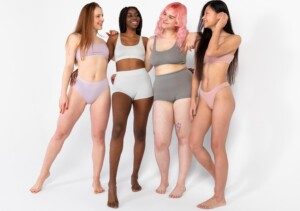
The woman on the left could be classed as mesomorph. Next to her would be an ectomorph. Next to her would be endomorph. The woman on the right could be a mix of mesomorph and ectomorph. Freepik.
These three body types are general guidelines, and not all people will fit 100 percent into one of these types.
Jane and Jordynn appear to be endomorphic.
An Endomorphic Woman Won’t Bulk up if She “just Looks” at Weights
Those with an endomorphic and mesomorphic build can add lean muscle tissue easier than can an ectomorph.
However, this does not translate to bulking up with little effort! It’s a relativity issue.
On average, women have one-tenth the testosterone circulation as do men.
Testosterone is crucial for building muscle mass.
Women also have a baseline of much less muscle to begin with.
So the idea that a woman can pack on muscle so easily that she’ll avoid strength training altogether is nothing short of madness – even if she’s “naturally muscular” — and that descriptor is highly subjective.
I’ve had women tell me they’re muscular when, in fact, they were not.
When I was a personal trainer I had overweight endomorphic clients tell me that the size of their legs was “mostly muscle.”
A bodyfat measurement with skin-fold calipers easily squashed their observation.
This isn’t to say that anomalies don’t exist, though. They most certainly do.
Women who excel in natural (no steroids) bodybuilding contests or are notably muscular often have a mesomorphic build to begin with.
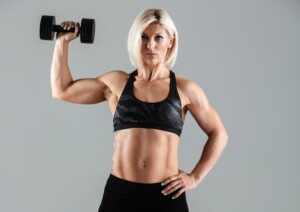
Freepik/drobotdean
This also goes for women athletes who are more muscled than what their sport is usually associated with, such as tennis, soccer, softball and volleyball.
Jane and Jordynn completely lack an athletic looking base to their bodies.
I don’t say this to be critical; I say this to point out that usually, when a woman claims they pile on muscle quickly from basic strength training, their bodies look average, rather than gifted with a natural base of muscle!
It’s not like when they walk down the street in a tank top and shorts, people will think, “Hmmm, I bet she works out.”
The irony is that both Jane and Jordynn claim they’re pretty strong, even though neither lifts weights.
I’m not buying that they’re strong, especially the mom. When a woman is truly strong, she looks it.
This doesn’t mean she has hulking muscles. It means she looks – at a minimum – “trained.”
In fact, she might even be overweight — yet still look like she seriously trains at the gym — because she does.
I’m 100% confident that Jane would struggle to deadlift 85 pounds and would wipe out very quickly with a farmer’s walk of only 20 pounds in each hand. I’m outright confident that she would not be able to bench press 75 pounds.
Same with Jordynn, though I’m very sure that Jordynn would win out in aerobic based activity when compared to her mother.
There is nothing about Jane, Jordynn or other women who’ve made the same claim that suggests they have as much testosterone circulating in their bodies as do men.
Nor do they look like they have a baseline muscle mass that’s comparable to the average non-trained man.
Strength Not Always an Indicator of High Muscle Mass
Have you ever seen someone move a lot of weight but who didn’t look strong enough to do it?
This can be explained by variables other than a large amount of muscle mass.
Three variables come to mind:
- Ratio of fast twitch to slow twitch muscle fiber
- Distance of tendon-insertion points from a joint
- Anthropometrics
When someone has all three of these innate features, they have a massive head start in strength or power based sports.
They will also build muscle faster than average because they can get stronger faster – due to these three blessings.
You can’t really tell by looking at someone, who’s not trained, what their fast to slow twitch muscle ratio is.
Someone might have a high proportion of fast twitch fibers, but if they haven’t trained or developed those muscles, they won’t necessarily look “explosive” or particularly muscular.
Distance of tendon-insertion points (where tendons attach muscles to bones) can be tricky to identify, especially without imaging tools or deep anatomical knowledge.
Even trained professionals like physical therapists or personal trainers sometimes rely on palpation and movement tests to get a clear picture.
As for anthropometrics, this can refer to limb and body part proportions, among other relative metrics.
Limb/body part proportions can be seen! I once saw a lanky man effortlessly doing deadlift reps of 315 pounds.
I swear, this man’s body looked as though it had never seen the light of a gym.
But I also noticed he had a long torso, short thighs, and arms that were long relative to his height. This meant he didn’t have to bend over very far to grip the barbell, reducing load on his lower back and distributing more of it to his legs!
These proportions cast an advantage with the deadlift (and also the squat). No wonder he was much stronger than he looked!
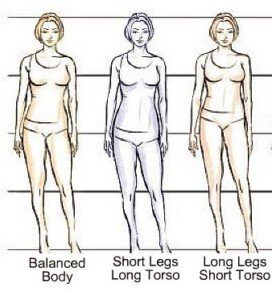
Different body proportions can affect execution in certain sports. All three women here are the same height, weight and basic body build. The one in the middle would find it easier to pick heavy objects off the floor, when compared to the long legged woman. The combination of short torso and long femurs would require the woman on the right to bend over more to grasp the object, putting more strain on her lumbar spine. The middle woman, due to a longer torso at the same overall height, could pick up the object with less bending over. This would mean more of the resistance would be absorbed by her legs, and less by her lower back, allowing her to lift with less struggle. She’d be “stronger.”
Women Only Imagine They’ll Bulk Up
The funny thing is that women such as Jane and Jordynn don’t realize just how much effort and training are required to build impressive looking muscle.
Their comments of “I’ll bulk up if I just look at a weight” are the laughing stock of female bodybuilders who must train many hours, very intensely, all year ‘round to achieve what is typically thought of as a “too muscular” physique.
- Ask any competitive female bodybuilder just what she must do to look the way she does.
- Ask her how many hours a week she spends training.
- Ask her about her diet.
- Then ask her how it’s even remotely possible for a woman with average genetics to pack on muscle with basic strength training only two hours per week.
Do these “I’ll bulk up” women not realize just how much work is involved in getting big muscles?
To say, “If I do even light strength training just for fitness I’ll bulk up,” is like saying, “If I just dabble my foot in the water I’ll turn into a fish.”
Okay, I know that’s stretching it, but come ON, we need to think straight here and not allow ourselves to become deluded out of some unrealistic prediction of looking like an Olympic shot putter if all you do is train with weights for fitness!
What It Really Means
It seems as though some women are caught up in societal norms: It’s still not generally acceptable for a woman to look strong and athletic (note: I said “strong,” not bulked up).
In fact, look at movie starlets of generations ago. It was unthinkable for them to have any arm tone. Their arms were considered thin or slender, but objectively, there was little tone.
Forty-five years ago, a woman who would’ve been considered too muscular or “overdone” with the weight workouts TODAY would finish in last place in a natural bodybuilding contest.
Society has made some progress in embracing muscles on a woman.
But there’s a way to go. There still exists some frowning-upon when it comes to a woman’s body appearing strong and well-trained.
Need proof? Look no further than one of the biggest examples of this stigma: tennis champion Serena Williams.
Even a world-class female athlete still gets criticized for being too muscular!
It’s no wonder so many women refuse to strength train.
They might be fearing that even a little more visible muscle will get them negative attention.
So they convince themselves they’ll bulk up if they train with even light dumbbells.
Ladies, unless you have abnormally high levels of testosterone and a high baseline of muscle AND deliberately train for muscle size and especially take anabolic steroids – you will NOT bulk up.
 Lorra Garrick is a former personal trainer certified by the American Council on Exercise. At Bally Total Fitness, where she was also a group fitness instructor, she trained clients of all ages and abilities for fat loss and maintaining it, muscle and strength building, fitness, and improved cardiovascular and overall health.
Lorra Garrick is a former personal trainer certified by the American Council on Exercise. At Bally Total Fitness, where she was also a group fitness instructor, she trained clients of all ages and abilities for fat loss and maintaining it, muscle and strength building, fitness, and improved cardiovascular and overall health.
.



